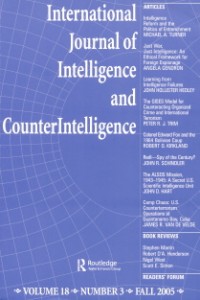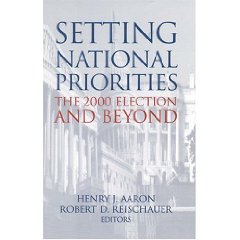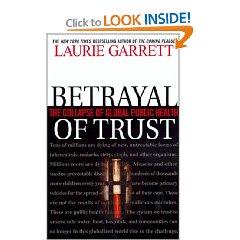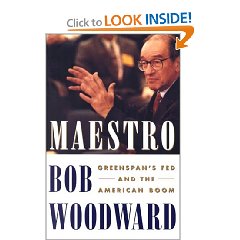2000 IJIC 13/4 Possible Presidential Initiatives (Before 9-11)
Articles & Chapters, Intelligence (Government/Secret), Intelligence (Public)Review: Present Dangers–Crisis and Opportunity in American Foreign and Defense Policy
5 Star, Asymmetric, Cyber, Hacking, Odd War, Terrorism & Jihad, Threats (Emerging & Perennial)Well-footnoted and indexed, this is a very serious professional contribution to the rather lackluster national discussion about where our national security and foreign policy should be going. As one who previously advocated a change from 2+ major regional conflicts (MRC) to 1 MRC and three separate forces for dealing with crime, environmental and cultural movements, and electronic and economic warfare (1+iii), I am now fully persuaded, mostly by the Kagan's book “While America Sleeps” but also by this book, that we absolutely must go toward a 2+iii national security strategy.
My one concern about this book is that it completely ignores what is quaintly called Program 150-all that State Department, Peace Corps, Agency for International Development stuff. It also mentions intelligence and counterintelligence only in passing. Conservative internationalists clearly have the brain power and the strategic vision and the historical understanding to be vital protectors of America's interests, but they must expand their vision to go beyond guns and consider the potential contributions of both diplomatic and economic butter, and applied intelligence. There is in fact a need to have a very strong Presidential program that fully advances, in an integrated fashion, American investments in diplomacy, defense, transnational crime fighting, economic assistance including a Digital Marshall Plan, and cultural exchanges worthy of a great Nation. This book lacks an appreciation for all the “soft” stuff, but it covers three of the four bases very nicely. A “strong buy.”

Review: While America Sleeps–Self-Delusion, Military Weakness, and the Threat to Peace Today
5 Star, Force Structure (Military), Military & Pentagon Power, Misinformation & Propaganda, Politics, Terrorism & Jihad, Threats (Emerging & Perennial)Especially gripping for anyone who anticipates a future in which Dick Cheney and Colin Powell have something to say about our national security, is the authors' analysis of their strategic decisions following the Cold War. Both Cheney and Powell get very high marks for understanding that global strength is a pre-requisite for stability and security. The Powell vision for a Base Force with Atlantic, Pacific, Strategic, and Contingency force elements is categorized as brilliant. Powell does, however, get very low marks for being consistently unwilling to use force to impose order in the absence of clear objectives-the authors are very clear in calling the Weinberger Doctrine (setting conditions under which force may be used) completely out of date and at odds with today's needs. Both President Bush and Chairman Powell are severely castigated for having ended the Gulf War too soon and without a decisive result-the author's compare this to the similarly indecisive outcome of World War I, an outcome that left the aggressors strong enough to come back and fight another day.
The authors then go on to systematically review a series of major foreign policy and defense failures in the Clinton administration, an Administration characterized by a consistent failure to understand and address the mismatch between wandering and vacillating foreign policies and attendant commitments, and the real-world capabilities of a declining military force. Especially dangerous, in the authors' view, was the Bottom Up Review approach that abandoned the Cheney-Powell appreciation for maintaining sufficient force to deter two regional surprise attacks (Russia and Iraq on one side, China and North Korea on the other), and instead adopted the premise that 6 months warning would be available, that reconstitution of both the force and its industrial base was possible, and that forces could be justified only in terms of existing threats, most of them from non-state actors. Bosnia, Somalia, Haiti, Iraq inspections, North Korea inspections, these are all reviewed and all are found to have left America with a legacy of half measures. “By trying to ignore the problem, to leave it to others, whether the UN or NATO, by declaring it to be of no vital interest to the United States, by refusing to use any force once involved and then to use adequate force once committed, they [Bush Sr. and Clinton] found themselves making the very mistakes that brought defeat and disaster in Vietnam, the fear of which had played so great a role, first in their failure to act and then in their inadequate response.”
In their conclusion, the authors find that the next Administration will assume responsibility at a time when the rest of the world has learned, from the past eight years, that America is not willing to summon the forces to defeat aggression; that developing weapons of mass destruction is the fastest means to elicit billion dollar bribes from America; that ethnic cleansing and politically driven mass starvation will not inspire intervention by America. “The most likely American response will be neglect, at first, followed by some attempt at negotiation. If, at last, driven to action, the Americans attack, it will be from the air, employing limited rules of engagement, and it will not destroy the aggressor. Ground forces will almost certainly not be used until the aggressor himself invites them in as part of a negotiation that gives him [the aggressor] most of what he wants. Above all, he should be sure to develop weapons of mass destruction. Even the hint of such a program in a threatening country will bring high-level American officials on top-secret missions to bribe its leaders to abandon the program. They will probably be able to keep the bribe and to pursue the programs they like, as well. These are the lessons America has given the world in the past eight years…”
The book closes by concluding that the strategic pause is gone and it is almost too late. Forces have declined severely (one can only lament the ill-considered Navy program for decommissioning destroyers and frigates that, once decommissioned, are almost impossible to resurrect), coalitions and alliances are in disarray, and non-state actors have learned how to play on the naiveté of the U.S. Government. America's responsibilities for global stability and security are “inescapable”, and the next President must make the necessary commitments and be materially and morally ready to meet them.

Review: Setting National Priorities–The 2000 Election and Beyond
4 Star, Politics, PrioritiesThe public policy overviews by Brookings are always among the best, and they are even more valuable this year when several think tanks appear to have defaulted on their traditional role in offering up reviews for consideration by the transition team. Across the various issue areas, including international, social, domestic, and governance policy domains, they present thoughtful recommendations.
Unfortunately, despite their deep understanding of the dilemmas facing the next President, the book does not provide the two things I would most like to have seen: one or two page “decision-papers” that set out the choices to be made within each issue area, and the specific budget costs and timelines for those choices; and a larger over-all budget choice document in no more than 2 pages that outlines what changes might be made in both the budget construction already underway in CY 2001 that the new President can influence, and the budget to be prepared from scratch in CY 2002 that should reflect the vital trade-offs as well as the vital plus-ups that need to be made in defense, intelligence, public health, and education, to name just my top four. In defense and intelligence, my specific area of interest, I would have liked to see some specific recommendations, and their costs, for restoring the 450 ship Navy, creating the contingency and peacekeeping force as well as the humanitarian assistance and disaster relief forces, and some specifics on considerably reinforcing diplomatic, peace corps, and economic assistance operations including a Digital Marshall Plan. This is not to quarrel with findings and views of the authors, all of whom merit very serious consideration, but rather to note that the book does not go far enough, either in specific programmatic terms, or in politically useful presentation terms.
This is an excellent book, but it is also a classic example of unfettered brilliance-without the concise decision papers and the over-all budget numbers, this book will only be read by staffers, not by principals, and that is a shame, because on balance I think there is a great deal to be learned from each of the authors contributing to this work.

Review: Betrayal of Trust–The Collapse of Global Public Health
4 Star, Asymmetric, Cyber, Hacking, Odd War, Atlases & State of the World, Complexity & Catastrophe, Corruption, Culture, Research, Disease & HealthIt took me over a month to do justice to this book, and I have taken into account the thoughts of other reviewers. A book of this importance would indeed have benefited from an international advisory board of public health, medical, insurance, and policy experts; it would certainly have benefited from greater structure, firmer editing, and a foreword by someone like a former Surgeon General of the United States. As it is, it appears to have overcome these deficiencies with hyped-up marketing and sweetheart reviews, and this in some ways counterproductive because this book could have, should have, become a mainstream topic in the Presidential campaign. It failed to do so for several reasons, not least of which is the propensity of both candidates and their advisors to avoid serious thinking, but also because the book is not helpful to a popular understanding of the very real global and domestic threats to the health of our children today and in future generations. Having said all this, I commend the book for its content and do not recommend it as avocational reading. There are some very important points that the book brings out, and I will itemize these in order of importance: 1) Public health is about detection and prevention, medicine is about remediation. In the long run, investments in public health are vastly cheaper and more effective than after-the-fact medical intervention; 2) The insurance industry in the developing world has failed to support public health investments, and in a remarkable collusion with the pharmaceutical, hospital and managed health care industries, has created a very expensive and increasingly ineffective system focused on drugs (to which diseases are increasingly resistant) and hospitals; 3) Hospitals are no longer reliable in terms of protecting patients from both error and secondary infection from other patients. People are coming out of hospitals, in many cases, with more diseases than when they went in; 4) The health of our nation depends on the health of all other nations-not only does a collapse of public health in Africa lead to failed states and forced migrations, but it also is but an airline flight away from infecting Kansas; 5) Clean drinking water, uninfected food, and good environmental and occupational health conditions are at risk in many parts of the United States and Europe, not only in Russia and the rest of the world; 6) The United Nations, and the World Health Organization in particular, are in disarray and ineffective-in large part because of a lack of support from member nations-at dealing with the public health commons. There is no question but that the author has hit a “home run” in terms of describing the harsh reality of epidemics in India and Africa, the collapse of public health in Russia, the rapid migration of many diseases from Russia through Germany to the rest of Europe and the U.S., and the severe costs in the U.S. of a retreat from the collective good with respect to public health. Unfortunately, it is a home run hit in isolation, not a game-winning home run, because it fails to drive home, to the only audience that matters-the U.S. voter-exactly what political and economic initiatives are required to achieve three simple objectives: 1) re-establish the public health infrastructure in the U.S.; 2) redirect the entire health care industry toward preventive measures-including water and food quality controls-instead of remedial prescriptions; and 3) provide compelling incentives to the rest of the world for cleaning their own house (this presumes that we are able to clean our own first, a very questionable assumption at this point in time). This is a valuable book, a five in terms of intent, a three in terms of execution, and I am glad that I took the time to read it. It provides a wonderful foundation for enjoying, at an intellectual and policy level, the medical and public health novels by Robin Cook.









